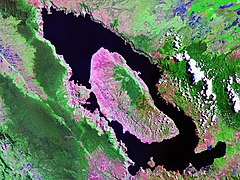
Back نظرية كارثة توبا Arabic Вядомыя вывяржэнні вулкана Тоба Byelorussian তোবা বিপর্যয় তত্ত্ব Bengali/Bangla Teoria de la catàstrofe de Toba Catalan Tobská katastrofa Czech Toba-Katastrophentheorie German Teoría de la catástrofe de Toba Spanish Tobaren katastrofearen teoria Basque نظریه فوران آتشفشان توبا Persian Théorie de la catastrophe de Toba French
| Toba eruption theory | |
|---|---|
 Artist's impression of the eruption from about 42 km (26 mi) above northern Sumatra | |
| Volcano | Toba Caldera Complex |
| Date | c. 74,000 years BP |
| Location | Sumatra, Indonesia 2°41′04″N 98°52′32″E / 2.6845°N 98.8756°E |
| VEI | 8 |
| Impact | Impact disputed |
| Deaths | (Potentially) almost all of humanity, leaving around 3,000–10,000 humans left on the planet |
 Lake Toba is the resulting crater lake | |
The Toba eruption (sometimes called the Toba supereruption or the Youngest Toba eruption) was a supervolcano eruption that occurred about 74,000 years ago during the Late Pleistocene[1] at the site of present-day Lake Toba in Sumatra, Indonesia. It is one of the largest known explosive eruptions in the Earth's history. The Toba catastrophe theory is that this event caused a severe global volcanic winter of six to ten years and contributed to a 1,000-year-long cooling episode, resulting in a genetic bottleneck in humans.[2][3] However, some physical evidence disputes the association with the millennium-long cold event and genetic bottleneck, and some consider the theory disproven.[4][5][6][7][8]
- ^ "Surprisingly, Humanity Survived the Super-volcano 74,000 Years Ago". Haaretz.
- ^ Ambrose 1998.
- ^ Michael R. Rampino, Stanley H. Ambrose, 2000. "Volcanic winter in the Garden of Eden: The Toba supereruption and the late Pleistocene human population crash", Volcanic Hazards and Disasters in Human Antiquity, Floyd W. McCoy, Grant Heiken
- ^ "Toba super-volcano catastrophe idea 'dismissed'". BBC News. 30 April 2013. Retrieved 2017-01-08.
- Choi, Charles Q. (2013-04-29). "Toba Supervolcano Not to Blame for Humanity's Near-Extinction". Livescience.com. Retrieved 2017-01-08.
- ^ Yost, Chad; et al. (March 2018). "Subdecadal phytolith and charcoal records from Lake Malawi, East Africa imply minimal effects on human evolution from the ~74 ka Toba supereruption". Journal of Human Evolution. 116. Elsevier: 75–94. doi:10.1016/j.jhevol.2017.11.005. PMID 29477183.
- ^ Ge, Yong; Gao, Xing (2020-09-10). "Understanding the overestimated impact of the Toba volcanic super-eruption on global environments and ancient hominins". Quaternary International. Current Research on Prehistoric Central Asia. 559: 24–33. Bibcode:2020QuInt.559...24G. doi:10.1016/j.quaint.2020.06.021. ISSN 1040-6182. S2CID 225418492.
- ^ Hawks, John (9 February 2018). "The so-called Toba bottleneck didn't happen". john hawks weblog.
- ^ Singh, Ajab; Srivastava, Ashok K. (2022-06-01). "Had Youngest Toba Tuff (YTT, ca. 75 ka) eruption really destroyed living media explicitly in entire Southeast Asia or just a theoretical debate? An extensive review of its catastrophic event". Journal of Asian Earth Sciences: X. 7: 100083. Bibcode:2022JAESX...700083S. doi:10.1016/j.jaesx.2022.100083. ISSN 2590-0560. S2CID 246416256.
© MMXXIII Rich X Search. We shall prevail. All rights reserved. Rich X Search